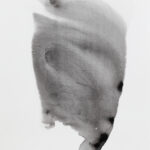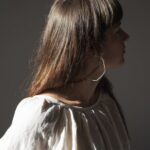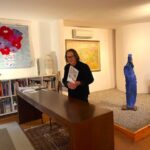SANDRINE CERDAN – Painter and Engraver
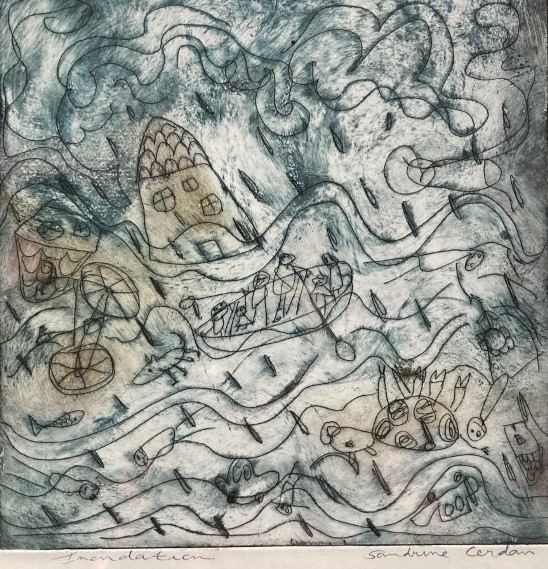
As announced, I have decided to resume writing my blog with a view to presenting artists living in the Drôme whose work in my view stand out because of its quality and originality. More than ever in our unsettling times full of false statements and arguments artists can help us see clearly since they express truths that come from the heart.
It doesn’t often happen that a work of art makes me stop and come back a second and a third time to examine it all over again. I love art and can’t have enough of it but there are times when l am taken completely unawares, and what I see touches me deeply. That is exactly what happened when I recently visited Sandrine Cerdan’s exhibition at the gallery of the Chant Libre library in Montélimar. Hanging on the wall a square etching of 25cm x 25cm, a maze of lines all in curves and whirls caught my attention and I immediately decided to buy it. From a distance it could well have been a piece of automatic drawing. In its own right the composition with dark areas on both sides and a lighter central part with vague ochre-coloured patches was pleasing and harmonious but a closer look revealed turmoil and a scene of devastation. The whirly lines turned out to be giant waves sweeping away everything in their wake and out of the sky laden with stormy clouds, deadly raindrops like bullets come pelting down.
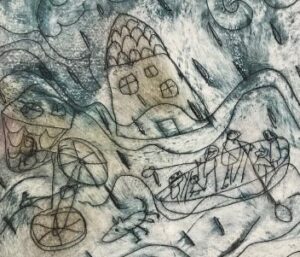
Among the wreckages in the raging waters a house is toppling over, people in a boat try to save their lives, animals are drowning. The title of the etch is “Inondation” or Flood and in her free drawing style Sandrine has managed to capture the very essence of the drama that is taking place. It reminds me of the many paintings and drawings by 17th century Dutch painters who recorded the terrible floods that frequently invaded the Low Lands. But it could just as well have been inspired by one of the cataclysmic flood scenes we too often see nowadays on television as a result of global warming. Seen through the sensitive eyes of an artist this small etching conjures up within a minimum amount of space what a natural disaster can bring about on a vast scale. In my mind this is one of the effects a work of art can have on the beholder, that words, facts and figures can’t.
A number of similar paintings on show at the exhibition made me want to know more about the artist and dedicate my first blog of the upcoming new series to what motivates the choice of her subjects and the various techniques she uses to accomplish her work. We hadn’t met, so I decided to write and ask if she was interested and indeed so, could she please answer a little questionnaire I had prepared in view of an interview. My purpose was to go a bit beyond a routine interview that is often little more than a few biographical notes, a chronological list of exhibitions held by the artists and a few quotations taken from reviews of their work.
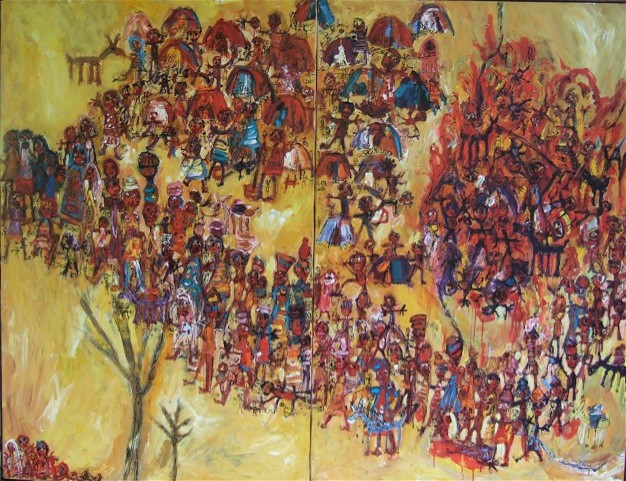
Exodus – Diptyque acrylics on canvas – 150 x 220 cm
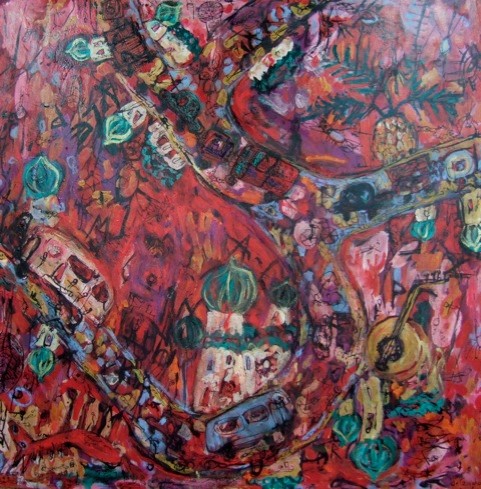
Syria – Acrylics on canvas – 100 x 100 cm
My first question was to sound out Sandrine’s own opinion regarding her art. Did she consider it to be autobiographical, socially engaged or simply “art pour art.” The answer she gave me certainly explains the idea behind the etching “Inondation” I purchased, but it also reveals an extremely wide range of interests. “Much of my work is socially engaged and even militant. I am inspired by the world I live in, current events, movements of populations, the historical background and development of places. The following titles of my works testify to the fact that all these subjects keep me busy: Upheaval, Exodus, Revolution, Flood… There is also a form of militantism in another work to which I have given the title, Ideas have Legs. But my work can also be poetic, light-hearted or simply abstract.”
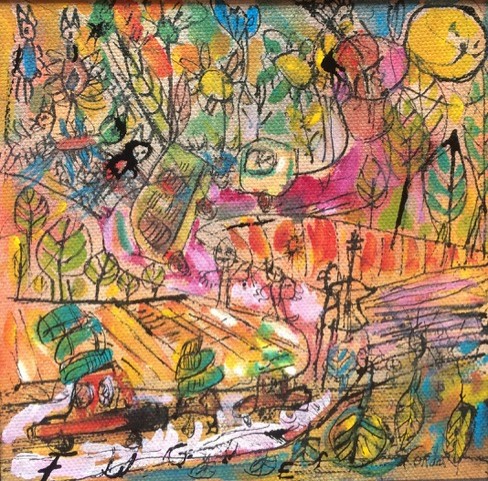
Flight – Acrylics on canvas mounted on wood – 20 x 20 cm. To flee where, or from misery, violence, fear. To hold on to nature, and the color of music
The use of a variety of techniques is characteristic of Sandrine’s creative process. “In the beginning I began by painting and drawing. Then followed etching and ceramics. To change techniques is a way of renewing oneself, and of approaching a subject differently. Every technique opens up a wide range of further prospects. When I make ceramics, I add volume to my work and I enjoy the feeling of solid matter in my hands. Having once mastered a number of techniques you can combine, mix, make them merge as often as you like. In the final analysis they are complementary. It’s very stimulating!
Having more or less established the subjects that interest her and the tools she uses in her work I asked Sandrine to tell me her reasons to become an artist. Why want to make art and whether she thinks it is useful? Doctors are trained to treat ill and disabled persons, architects to build houses and bridges, pilots to fly planes. But what is the purpose of art? In her own words Sandrine is socially engaged. What does she mean by that? Just consider the world around you and the dire need to improve human conditions, put a halt to climate disorder, to raging wars, etc. In this context, spending all one’s time in a studio to paint pictures or make engravings has the air of a hobby and seems a bit pointless. And yet artists spend a lifetime doing it and the onlooker doesn’t tire of looking at what they create.
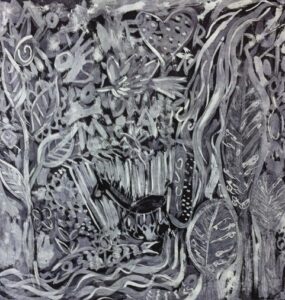
La tierra sin mal – Aquatint – 50 x 50 cm – Tribute to Raoul Barbosa (argentinian musician)
For the large majority of artists to make a living out of their art is uphill work. There are some 62.000 registered visual artists in France and only a little more than 2000 galleries of contemporary art! “Yes, it is true. I am a professional artist and what I earn out of the sales of my work is next to nothing. So, I have to organise workshops and run artistic residencies, and I am sometimes obliged to take on odd jobs to make ends meet. In my case, I no longer have a gallery as unfortunately what I make does not correspond to present trends. To participate in an art fair is too expensive. So, I mainly exhibit in libraries with a gallery, museums and in cloisters. However, that being said, everything interests me, I have an extremely curious nature and nothing will ever stop me from making art. Art is perhaps a means of transcending reality and of understanding and accepting it. At times it might be frightening and repel but it can also be a source of joy and of dreams and enlighten, console and appease.”
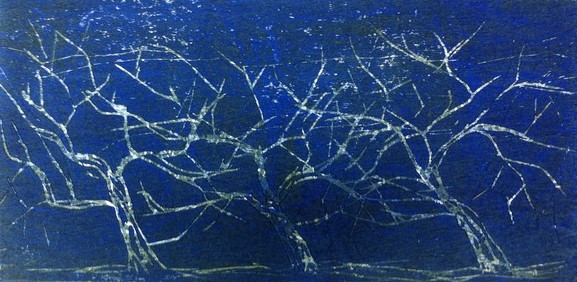
Pear tree- Xylogravure
Posted in: Art
